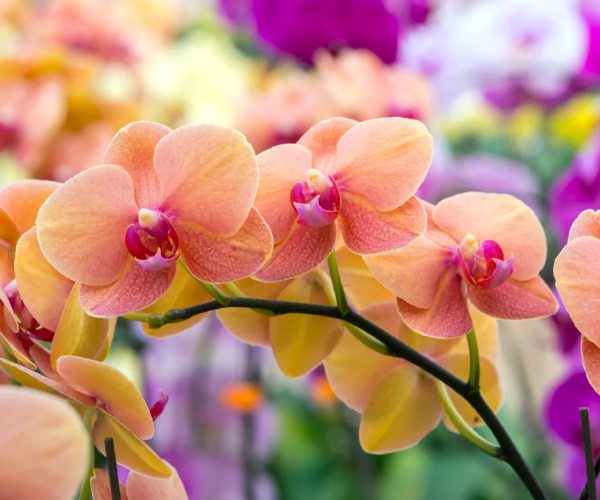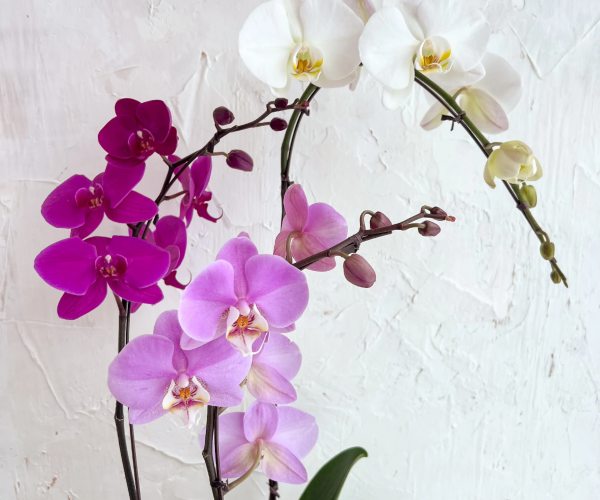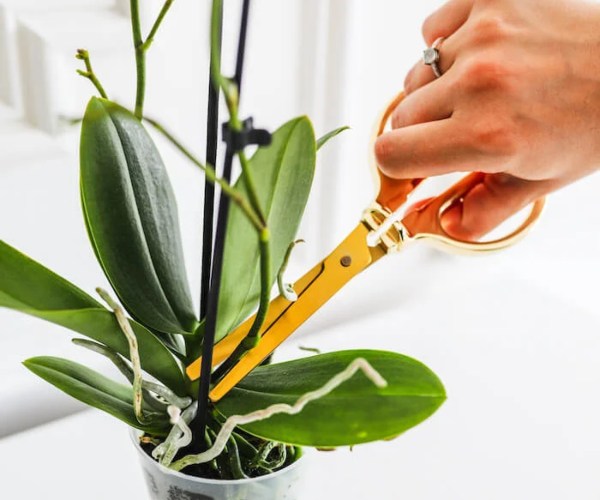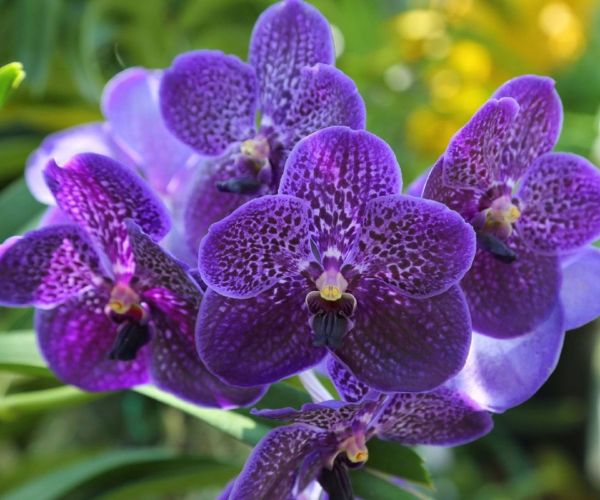Orchids (Orchidaceae) are popular houseplants that are super easy to grow and care for once you provide them with the ideal growing conditions and maintenance requirements. There are thousands of orchid species to choose from but the most common varieties are Phalaenopsis, Cattleya, Dendrobium, and Cymbidium.
Most of them have similar physical characteristics and spectacular blooms.
Plant Attributes
- Common Name: Orchids, moth orchid, corsage orchid, boat orchid
- Botanical Name: Orchidaceae
- Family: Orchidaceae
- Plant Type: Perennial, herbaceous
- Mature Size: 1–3 ft. tall, 6–12 in. wide
- Sun Exposure: Partial Shade
- Soil Type: Well-drained
- Soil pH: Acidic
- Bloom Time: Varies
- Flower Color: Pink, purple, white, red, yellow, orange, green
- Hardiness Zones: 5–11 (USDA)
- Native Area: North America, South America, Central America, Europe, Asia, Africa, Australia, Caribbean
- Toxicity: Non-toxic to pets
Orchid Care
The thumb rule for growing orchids indoors is to duplicate the plant’s natural growing behavior as closely as possible. The wild ones cling to rough bark and their roots are exposed to nature.
The orchid that you first get is likely to be healthy and in bloom but many store-bought orchids are potted in a medium that will likely cause root rot.
It is recommended never to repot an orchid while it is blooming. Just be patient and reduce the amount of water it receives until the blooms fade. Follow these simple tips and tricks to keep your orchid happy and healthy:

- Keep it in a location with plenty of bright, indirect light; a south- or east-facing window is perfect.
- Let the growing medium dry before you water.
- Feed your orchids with an orchid-specific fertilizer or a balanced fertilizer formula such as 20-20-20 at one-fourth strength after thoroughly watering the plant once a week. Once the plant goes dormant, especially in winter reduce the amount of fertilizer.
Light
Orchids require bright light to bloom. That being said, direct sun is not good for the plants as it can burn them. Choose a location that gives bright, indirect light, especially from a south- or east-facing window.
Soil
Remember that orchids will not thrive in regular potting soil or potting mix. Buy or make a DIY orchid-growing medium that is lightweight and fast-draining. Some common mixtures should be bark, sphagnum moss, perlite, and peat. A slightly acidic soil pH is ideal.
Water
Orchids normally require watering twice a week in the warmer months when they are actively growing. In colder months, watering once a week is enough. Water with room-temperature water until it comes out of the pot’s drainage holes.
To prevent root rot, they need to dry out between waterings only and if the growing medium is dry and the pot feels light, this is a sign that the plant needs water.
You can check with the roots as well. If they are plump and white or green, that is a sign that they are well-watered. Shriveled and gray means requiring water. If they’re shriveled but spongy and black or brown they might be rotting.
Temperature and Humidity
Based on classifications, orchids do best in ranges that are between 50 degrees and 90 degrees Fahrenheit. Their humidity preference is around 40% to 70%.
If you provide a warm and humid environment, the orchid might keep blooming some more. Don’t keep the orchid in an area where it gets cold drafts, exposure to direct sunlight, or dry air from heating vents.

Also, Read Plumosa Fern: How to Grow and Care for This Unique Houseplant
Fertilizer
During the growing season, use an orchid-based fertilizer, after reading label instructions. Prevent fertilizing during the winter months.
Orchid Care After Flowering
When the blooms fade, the maintenance should be long-term. Most gardeners snip off the old flower spike near the base. After the blooms fall off, you can repot your plant into a more suitable container with a light, porous growing medium and a pot that allows for good airflow and drainage. An unglazed clay or a pot specially designed for orchids with holes in their sides are the best options.
Types of Orchids
There are about 30,000 species of orchids live in the wild along with more than 100,000 registered hybrids. Knowing what variety you have is necessary for its care. The majority of commonly-available orchid groups for purchase are:
- Phalaenopsis (moth orchids): They have round flowers with pronounced lips that grow on a single tall stalk arising from a whorl of fleshy, oval leaves. Flowers come in usually white, purple, pink, or a combination.
- Dendrobium (cane orchids): They have small flowers that grow in rows on stalks that rise from thick canes, often with several flower clusters per plant. Flowers are white or purple. Dendrobium leaves are narrow and emerge from the sides of the cane.
- Cattleya (corsage orchids): They are the most frequently used orchids in corsages, Cattleya orchids have been widely hybridized, leading to a large variety of colors and forms. Some varieties are quite fragrant and many have appealing freckles, streaks, or other bicolor features.
- Cymbidium (boat orchids): They have multiple flower spikes to ensure a great display. Good choices for beginners include the lime green ‘Chica’, the yellow and red ‘Showoff’, or the bright pink ‘Frae’, all recipients of the American Orchid Society’s Highly Commended Certificate.
Pruning Orchids
It is essential to prune the orchid properly as it will create a way for new blooms. While pruning an orchid, ensure that the tool is sterilized and sharp because clean-cutting promotes better health for the plant.

The pruning method is different for different orchids. Remove faded orchid blooms so that the plant can spend energy on new growths. After the flowering is complete, cut off the flower spike. Some orchid varieties rebloom on the same spike. If that happens, you should remove the faded blooms but not the spike.
Propagating Orchids
Propagating orchids by seed is difficult because the tiny seeds need extremely sensitive conditions that are hard to duplicate. Division is the most common way to propagate an orchid.
- Keep the growing medium moist so that it will be easier to remove the plant from the container.
- Check the roots of the orchid and remove the damaged or dead parts that look black, mushy, or paper-thin. Healthy roots are firm and plump.
- Pinch some parts of the roots and stems and if they won’t separate by hand, do it using a sharp and sterile cutting tool.
- Repot each plant in the new orchid growing medium, stake if necessary, and water regularly.
Potting and Repotting Orchids
If you notice the orchid’s roots growing out of the pot excessively or the growing medium has been damaged, that is the time for repotting. Repotting should be done only after the plant is done flowering.
- Gently take the orchid out from its old container, moistening the growing medium as necessary to make it easier to pull the plant out.
- Cut away any dead or damaged roots with a sterile cutting tool.
- Plant the orchid in a bit larger container, and fill around the roots with fresh growing medium.
- Stake the plant if needed to help it stay upright. Finally, new roots will grow throughout the medium.
TIPS
It is essential to always choose an appropriate orchid pot for a plant’s overall health:
- Clear plastic pots with multiple holes allow water to drain away and allow you to detect the health of the roots. Keep the pots in a more attractive ceramic outer pot.
- Terracotta is an inexpensive, popular choice because it dries out quickly.
- Specialty orchid pots have a lacework of holes on either side of the pot to allow air circulation around the roots. When purchasing one of these pots ensure that the holes are small as that won’t allow the potting media to fall out when watering.

Common Pests and Plant Diseases
Orchids luckily don’t have major pest issues. But they are susceptible to some common plant pests like aphids, fungus gnats, mealybugs, spider mites, scale, cigar-shaped thrips, and whiteflies.
Most of these pests can be eliminated by gently brushing off a jet of water or using insecticidal soap. Neem oil can also be used to control the insect population.
Also, the root rot which can happen due to overwatering can be the result of various fungal diseases like anthracnose, phytophthora (black spots on leaves), botrytis, leaf algae, and petal blight.
Common Problems With Orchids
Once the orchid gets adjusted to a suitable spot, it should produce healthy growth and gift you with a beautiful bloom. However, there might still be some issues.
Leaves Shriveled and Wrinkled
Shriveled or wrinkled leaves are trying to tell you that the orchid is not getting enough water. The problem here is mostly unhealthy roots. If the roots look black and mushy, remove them using a sterile cutting tool and repot them in a healthy and new growing medium. If the roots are green and white but the leaves are still shriveled, the plant needs water.
Yellow Leaves
Overwatering and root rot often cause yellow leaves. Allow the orchid growing medium to dry out between waterings. If that doesn’t work, repot the plant and remove any unhealthy roots.
Drooping Leaves
Underwatering can often cause the leaves to droop because these plants need a consistent level of moisture to thrive. Another reason for this could be a little light so locate the pot to a spot that gets bright and indirect light.
FAQs
Q: How do you get an orchid to bloom again?
A: To get an orchid to bloom again, you will need to prune the stem back and reduce the amount of fertilizer you are feeding it. Once a new leaf appears on the stem, you can resume your regular watering and fertilizing schedule.
Q: How long do indoor potted orchids last?
A: Indoor potted orchids can live a very long life given the right care, living for between 15 to 20 years.
Q: How long does it take for orchids to rebloom?
A: Orchids typically will rebloom within six to nine months, though sometimes it can take up to a year. Be patient with your orchid and make sure it is in a happy and healthy environment to encourage reblooming.
Also, Read These 15 Plants Will Keep Unwanted Bugs Out of Your Garden
